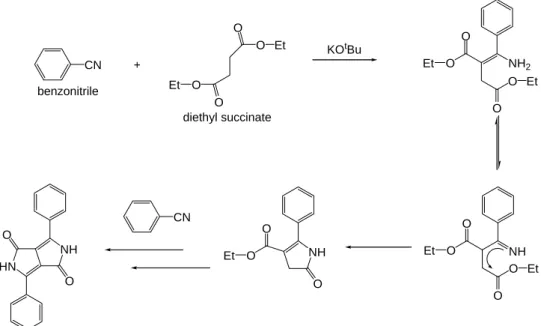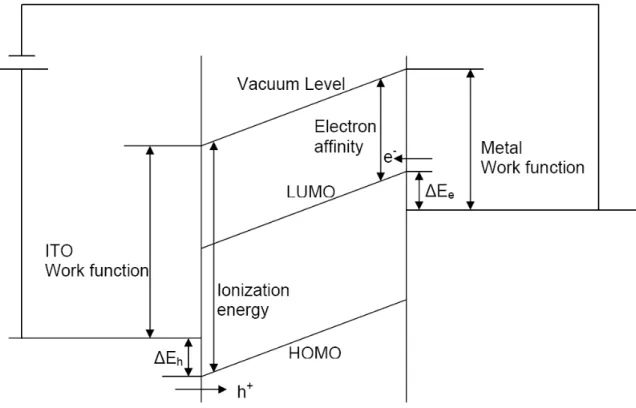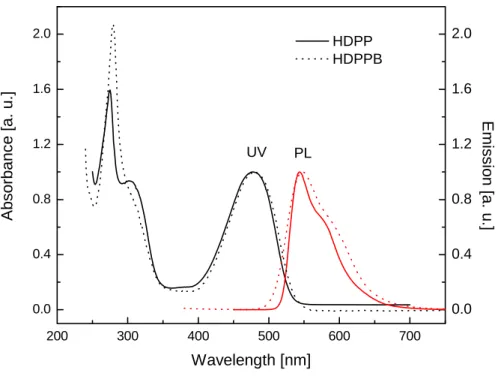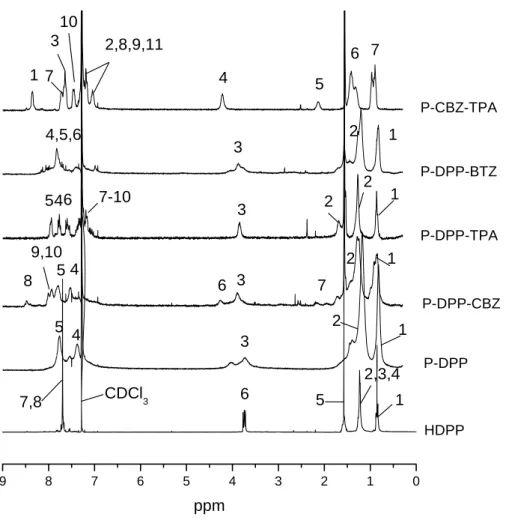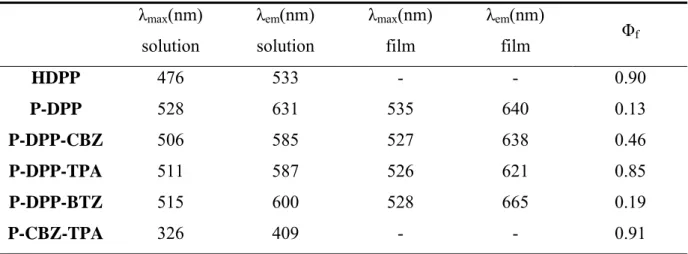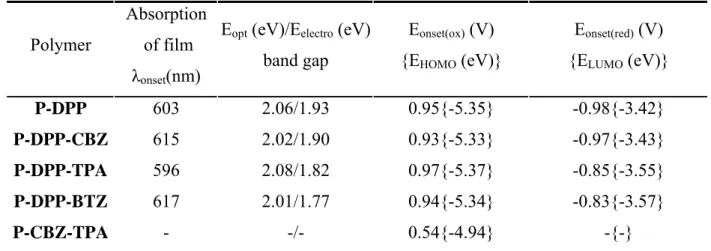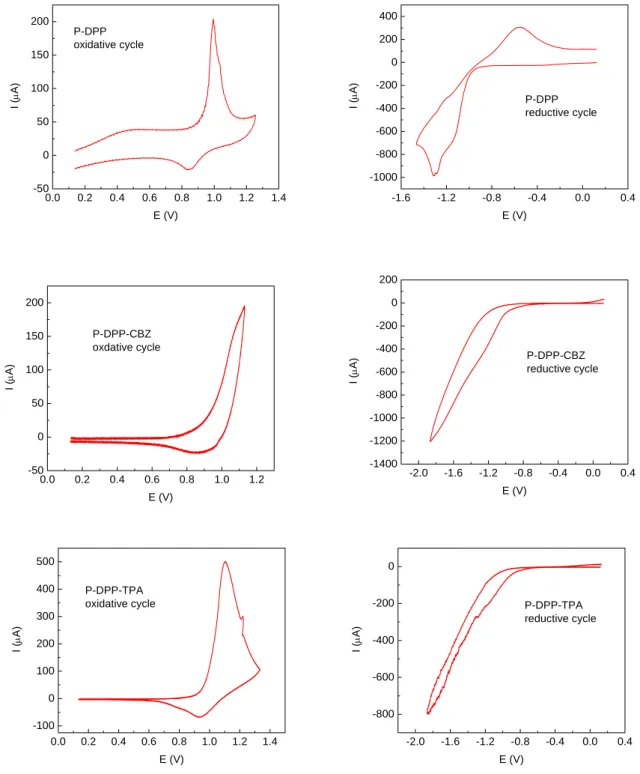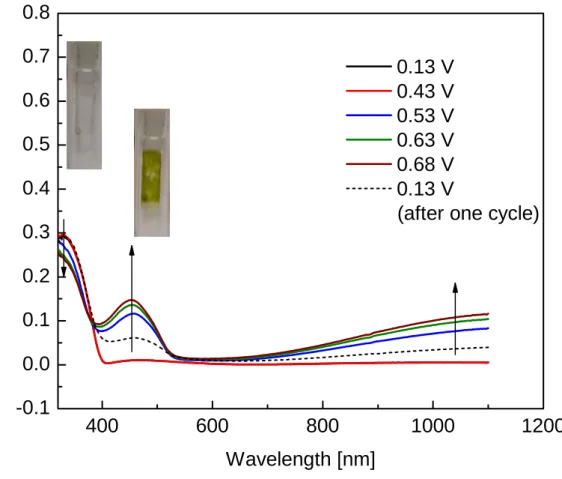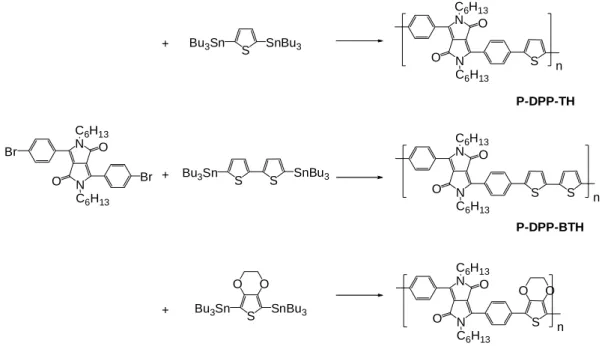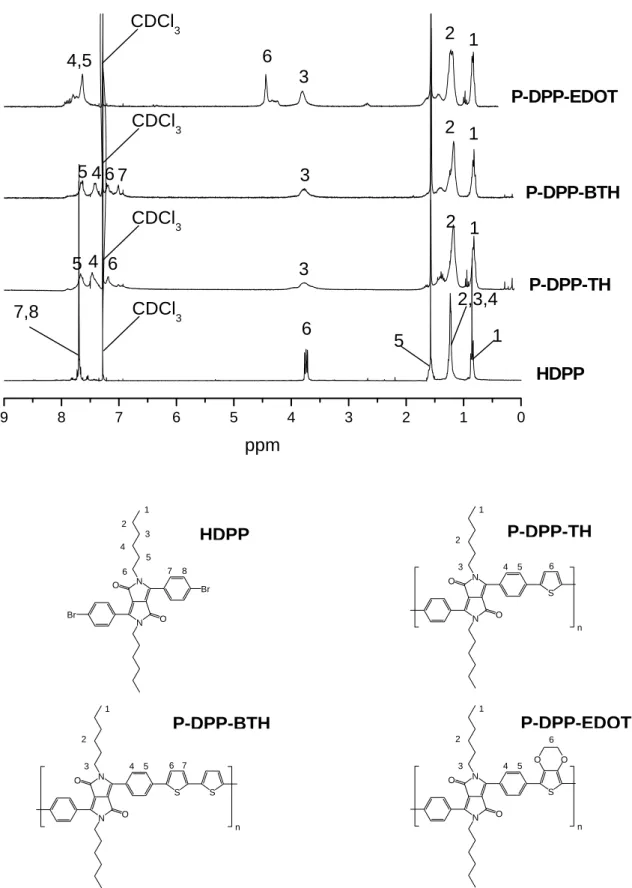New Diketopyrrolopyrrole(DPP)-Based
Conjugated Polymers Prepared upon Palladium Catalyzed Polymerization and Electropolymerization Reactions
Inaugural-Dissertation zur
Erlangung des Doktorgrades
der Mathematisch-Naturwissenschaftlichen Fakultät der Universität zu Köln
vorgelegt von
Yu Zhu aus V. R. China
Köln 2006
Referenten:
Prof. Dr. B. Tieke
Prof. Dr. H.-G. Schmalz
Tag der Prüfung: 14.02.2007
To my parents and Ying
List of symbols
δ Chemical shift
λ
maxMaximum absorption wavelength λ
emMaximum emission wavelength Φ
fPhotoluminescence quantum yield A Ampere
ANT Anthracene BTH Bithiophene
BTZ 2,1,3-Benzothiodiazole CBZ Carbazole
cm Centimeter
CV Cyclic voltammogram
DCM Dichloromethane
DMF N,N-Dimethylformamide DMSO Dimethylsulfoxide
DPP 1,4-Diketo-3,6-diphenylpyrrolo-[3,4-c]pyrrole EC Electrochromic
EDOT 3, 4-Ethylenedioxythiophene
EL Electroluminescent g Gram
GPC Gel-permeation chromatography
h Hour LED Light emitting diode min Minute mm Millimeter
NMP N-Methyl-2-pyrrolidon
NMR Nuclear magnetic resonance
PDA N,N'-Diphenyl-1,4-phenylenediamine PL Photoluminescence
PYRE Pyrene
RT Room temperature
SCE Saturated calomel electrode
SEC Size-exclusion chromatography
TBAN 4-t-Butylaniline
TBAPF
6Tetrabutylammonium hexafluorophosphate TH Thiophene
THF Tetrahydrofuran TPA Triphenylamine UV Ultraviolet V Volt
Vis Visible light
Abstract
Synthesis and characteristic properties of new conjugated polymers and polyelectrolytes containing DPP-units in the main chain are described. The polymers are synthesized upon palladium-catalyzed Suzuki, Stille and Buchwald-Hartwig polycondensation and electropolymerization. Characteristic properties such as molecular weight, structure, optical and electrooptical properties of the polymers are studied using gel permeation chromatography, spectroscopic methods (UV/vis, Fluorescence, NMR spectroscopy), cyclic voltammetry and spectroelectrochemical characterization.
Using the Suzuki, Stille and Buchwald-Hartwig coupling, conjugated polymers are synthesized from dibromo-DPP or the boronic ester of DPP and derivatives of the carbazole (CBZ), triphenylamine (TPA), benzothiadiazole (BTZ), thiophene (TH), bithiophene (BTH), 3,4-ethylenedioxythiophene (EDOT), pyrene (PYRE) or N,N'-diphenyl-1,4-phenylene diamine (PDA). The molecular weights of the resulting polymers are between 4.3 and 16.5 kDa. The polymers are soluble in solvents such as toluene, chloroform or THF forming red to purple solutions with strong photoluminescence. Compared with the DPP monomer, the optical properties of the polymers are bathochromically shifted due to the increase of the conjugated system. Polymers in solution exhibit absorption maxima between 506 and 560 nm, and fluorescence maxima between 585 and 635 nm. The polymer P-DPP-TPA exhibits a photoluminescence quantum yield of 85 %, which is the highest value reported for DPP containing conjugated polymers so far. Polymers of DPP and BTH, PDA and PYRE exhibit reversible electrochromic properties upon electrochemical oxidation and reduction. The abrupt colour changes from purple to dark blue to black-green are observed.
Furthermore, a series of electropolymerizable DPP containing monomer have been successfully prepared using Suzuki, Stille or Buchwald-Hartwig coupling. The in-situ formed polymer films are robust and insoluble in common solvents. They exhibit a very good stability during oxidation reduction cycles together with electrochromic properties. The polymer films are useful as active materials in electrochromic devices showing colour changes from blue to transparent, brown-red to olive-green, purple-red to brown-red, and colourless to green.
Conjugated polyelectrolytes were synthesized from bis-bromohexyl-DPP or bis-sulfonylbutyl-
DPP using Suzuki and Buchwald-Hartwig coupling. The resulting cationic and anionic
polyelectrolytes are readily soluble in water and polar organic solvents such as methanol and
DMSO. The polymers are non-luminescent in water, but exhibit photoluminescence quantum
yields between 6.2 % and 49 % in DMSO.
Abstract
Ziel dieser Arbeit war die Herstellung und die Charakterisierung von konjugierten Polymeren mit DPP-Einheiten in der Hauptkette. Die Polymere wurden mit Hilfe der Suzuki, Stille und Buchwald-Hartwig Kupplung so wie durch Elektropolymerisation hergestellt. Die Eigenschaften der resultierenden Polymere (Molekulargewicht, UV/vis, Fluoreszenz, NMR Spektroskopie, Zyklovoltammetrische Untersuchungen und spektroelektrochemische Charakterisierung) wurden untersucht.
Mit Hilfe der Suzuki, Stille und Buchwald-Hartwig Kupplung, wurden Dibromo-DPP oder Diboronester-DPP mit Carbazol (CBZ), Triphenylamin (TPA), Benzothiadiazol (BTZ), Thiophen (TH), Bithiophen (BTH), 3,4-Ethylenedioxythiophen (EDOT), Pyrene (PYRE) oder N,N'-diphenyl-1,4-phenylene diamin (PDA) gekupplet. Die Molekulargewichte der erhaltenen Polymere liegen zwischen 4.3 und 16.5 kDa. Die Polymeren sind in gängigen Lösemitteln wie Toluol, Chloroform, Dichlormethan oder THF gut löslich. Dabei bilderen sie stark fluoreszierende Lösungen. Die Absorptionsmaxima liegen zwischen 506 und 560 nm, die Fluoreszenz maxima zwischen 585 und 635 nm.
Weiterhin wurden DPP-Polymere durch Elektropolymerisation herstellt. Die Polymere sind unter Farbwechsel Oxidationsbeständig.
Konjugierte Polyelektrolyte wurde mit Hilfe der Suzuki und Buchwald-Hartwig Kupplungs
hergestellt. Die Polymeren sind löslich in Wasser, DMSO und Methanol.
TABLE OF CONTENTS
1. INTRODUCTION... 1
1.1. Diketopyrrolopyrrole (DPP)... 1
1.2. The chemistry of DPP ... 3
1.2.1. N-Alkylation... 4
1.2.2. Electrophilic aromatic substitution... 4
1.2.3. Nucleophilic aromatic substitution... 5
1.2.4. Transformations at the carbonyl group... 6
1.3. Conjugated DPP polymers... 6
1.4. Electroluminescent applications... 8
1.5. Electrochromic applications ... 11
1.6. DPP-based conjugated polyelectrolytes... 13
1.7. Motivation of the work... 14
2. CONJUGATED DPP POLYMERS PREPARED UPON PALLADIUM CATALYZED POLYCONDENSATION... 16
2.1. Suzuki coupling polycondensation... 16
2.1.1. Preparation of the monomers... 17
Preparation of DPP-based monomers ... 19
Preparation of other monomers ... 21
2.1.2. Polymerization... 22
2.1.3. Characterization of the polymers... 24
GPC ... 24
1
H-NMR ... 24
Optical properties ... 28
Electrochemical Characterization ... 31
2.2. Stille coupling polycondensation ... 36
2.2.1. Polymerization... 37
2.2.2. Characterization of the polymers... 38
GPC ... 38
1
H-NMR ... 39
Optical properties ... 40
Electrochemical Characterization ... 43
2.3. Buchwald-Hartwig coupling polycondensation ... 46
2.3.1. Polymerization... 47
2.3.2. Characterization of the polymers... 49
GPC ... 49
1
H-NMR ... 50
Optical properties ... 51
Electrochemical Characterization ... 53
2.4. Conclusions ... 56
3. CHAPTER III ELECTROPOLYMERIZATION OF DPP CONTAINING MOLECULES... 57
3.1. Introduction ... 57
3.1.1. Electropolymerization of pyrrole and its derivatives ... 59
3.1.2. Electropolymerization of thiophene and its derivatives (without EDOT)... 60
3.1.3. Electropolymerization of EDOT (3,4-(ethylenedioxy)thiophene) and its derivatives . 62 3.1.4. Electropolymerization using other building blocks... 64
3.2. Electropolymerization of DPP containing molecules ... 65
3.2.1. Synthesis and properties of sandwich-structured DPP monomers ... 66
Thiophene containing DPP monomers... 66
Pyrrole containing DPP monomers ... 71
Carbazole containing DPP monomers... 74
3.2.2. Electrochemical polymerization... 76
Device and method used for electrochemical polymerization ... 76
Characterization of Poly(BTH-DPP-BTH) films... 79
Characterization of Poly(EDOT-DPP-EDOT) films... 82
Characterization of Poly(PY-DPP-PY) films... 85
Characterization of Poly(CBZ-DPP-CBZ) film... 87
3.3. Conclusions ... 90
4. WATER SOLUBLE CONJUGATED DPP POLYMERS ... 92
4.1. Introduction ... 92
4.2. Cationic DPP containing conjugated polyelectrolytes ... 96
4.2.1. Preparation of the monomers... 96
4.2.2. Preparation of the neutral precursor polymers ... 100
4.2.3. Preparation of the cationic polymer ... 101
4.3. Anionic DPP containing conjugated polyelectrolytes ... 103
4.3.1. Preparation of the monomers... 103
4.3.2. Synthesis of the anionic polymer ... 106
Suzuki polycondensation... 106
Buchwald-Hartwig polycondensation ... 107
4.4. Conclusion ... 110
5. EXPERIMENTAL PART ... 113
5.1. Materials, instruments and general procedures ... 113
5.1.1. Materials ... 113
5.1.2. Instruments ... 113
5.1.3. Electropolymerization ... 113
5.2. DPP conjugated polymers via polycondensation reactions ... 114
5.2.1. Suzuki coupling... 114
1,4-Diketo-2,5-dihexyl-3,6-bis(4-bromophenyl)pyrrolo[3,4-c]pyrrole ... 114
1,4-Diketo-2,5-dihexylpyrrolo[3,4-c]pyrrole-3,6-diphenyl-4-pinacolato boronester .... 115
3,6-Dibromocarbazole... 116
3,6-Dibromo-9-ethylhexylcarbazole ... 117
3,6-Bis(4,4,5,5-tetramethyl-1,3,2-dioxaborolan-2-yl)-9-ethylhexylcarbazole... 118
4,4´-Dibromotriphenylamine... 119
4,4´-Bis(4,4,5,5-tetramethyl-1,3,2-dioxaborolan-2-yl)-triphenylamine... 120
4,7-Dibromo-2,1,3-benzothiadiazole ... 121
P-DPP ... 122
P-DPP-CBZ... 124
P-DPP-TPA ... 126
P-DPP-BTZ ... 128
P-CBZ-TPA... 130
5.2.2. Stille coupling... 131
2,5-Bis(tri-n-butylstannyl)thiophene... 131
5,5’-Dibromo-2,2’-bithiophene... 132
5,5’-Bis(tri-n-butylstannyl)-2,2’-bithiophene ... 133
2,5-Dibromo-3,4-ethylenedioxythiophene. ... 134
2,5-Bis(tri-n-butylstannyl)-3,4-ethylenedioxythiophene. ... 135
P-DPP-TH ... 136
P-DPP-BTH... 138
P-DPP-EDOT ... 140
5.2.3. Buchwald-Hartwig coupling ... 142
P-DPP-PDA... 142
P-DPP-PYRE ... 144
P-PY-TBAN ... 146
P-PY-ANT... 147
P-PY-PYRE... 148
5.3. DPP conjugated polymers via electropolymerization ... 149
5.3.1. Synthesis of the Precursors... 149
2-(tri-n-butylstannyl)thiophene ... 149
3-hexyl-thiophene... 150
2-(tri-n-butylstannyl)-4-hexyl-thiophene ... 151
2-(tri-n-butylstannyl)-3,4-ethylenedioxythiophene... 152
5.3.2. Synthesis of the monomers and electropolymerization... 153
1,4-Diketo-2,5-dihexyl-3,6-bis(4-(2-thienyl)phenyl)pyrrolo[3,4-c]pyrrole... 153
1,4-Diketo-2,5-dihexyl-3,6-bis(4-(2-(4-hexylthienyl))phenyl)pyrrolo [3,4-c]pyrrole... 155
1,4-Diketo-2,5-dihexyl-3,6-bis(4-(2,2'-bithiophen-5-yl)phenyl)pyrrolo[3,4-c]pyrrole . 157 1,4-Diketo-2,5-dihexyl-3,6-bis((2-(3’,4’-ethylenedioxy)thienyl)-phenyl)pyrrolo[3,4- c]pyrrole ... 159
1,4-Diketo-2,5-dihexyl-3,6-bis(4-(1-(t-butoxycarbonyl)-1H-pyrrol-2-yl)- phenyl)pyrrolo[3,4-c]pyrrole... 161
1,4-Diketo-2,5-dihexyl-3,6-bis(4-(pyrrol-2-yl)-phenyl)pyrrolo[3,4-c]pyrrole ... 163
1,4-Diketo-2,5-dihexyl-3,6-bis(4-N-carbazolylphenyl)pyrrolo[3,4-c]pyrrole... 164
5.4. Water-soluble DPP containing conjugated polyelectrolytes... 166
5.4.1. Synthesis of the monomers... 166
1,4-Diketo-2,5-bis(1-bromohexyl)-3,6-bis(4-bromophenyl)pyrrolo[3,4-c] pyrrole ... 166
1,4-Dibromohexyloxybenzene ... 168
1,4-Dibromo-2,5-dibromohexyloxybenzene... 169
1,4-(4,4,5,5-Tetramethyl-1,3,2-dioxaborolan-2-yl)-2,5-dibromohexyloxybenzene ... 170
5.4.2. Synthesis of the polymers... 171
P-BrDPP-BrPH... 171
P-AMDPP-AMPH... 173
P-SDPP-PH ... 174
P-SDPP-AB... 176
P-SDPP-ABS... 178
6. SUMMARY... 180
7. REFERENCES ... 185
8. ACKNOWLEDGEMENT... 201
9. PUBLICATIONS AND CONFERENCES ... 202
10. CURRICULUM VITAE ... 203
1. Introduction
1.1. Diketopyrrolopyrrole (DPP)
In 1974, Farnum, et al.
1briefly reported the attempted synthesis of 2-azetinones according to the following reaction (Scheme 1.1). The desired reaction failed. Instead, the diphenyl DPP derivative was isolated in 5-20% yield.
CN + BrCH2CO2CH3
HN O
NH HN
O
O Zn
Scheme 1.1 Preparation of DPP (Farnum, et al. 1974)
However, the important physical properties of the DPPs such as high melting points (>350
o
C), insolubility in most solvents and brilliant red colour remained unnoticed due to its too poor yield. In 1980, researchers from Ciba-Geigy (now Ciba Specialty Chemicals) took notice of this reaction in a compilation of interesting reactions published by Ranganathan in 1980
2. Then the chemistry and applicatory properties were developed
3,4, and in 1986 the first DPP pigments have been developed and introduced to the market for conventional pigment applications like paints, plastics, fibers and inks.
Besides the original report from Farnum
1, there are several reports for the synthesis of DPP
pigments
5-7. Among all these methods, the succinic ester route is regarded as the best one
5,6.
In this route, succinic ester is condensed in a pseudo-Stobbe condensation with an aromatic
nitrile in the presence of strong base to afford the desired DPP in a yield over 60% (Scheme
1.2). The key-step of the mechanism is the formation of pyrrolinone esters from the initially
formed enaminoesters, then it can further react with another benzonitrile under basic
conditions. Subsequent ring closure affords the DPP compounds.
CN +
O O
O O Et
Et KOtBu
NH2 O
O Et
O O Et
NH O
O Et
O O Et NH
O O
O Et CN NH
O HN
O
benzonitrile
diethyl succinate
Scheme 1.2 Preparation of DPP via the succinic ester route
a) Absorption spectra of DPP in solution (DMSO) and in the solid state
b) Absorption and emission spectra of DPP in solution (CHCl
3)
Figure 1.1 UV/vis absorption and photoluminescence spectra of diphenyl-diketopyrrolopyrrole
The synthesis of DPP pigments was discussed in a series of publications from Morton and Riggs
8-10. More recently, the synthesis of unsymmetrical DPP
11,12was reported. Some new synthetic methods such as the microwave route
13have also been reported.
The diketopyrrolopyrrole is a bicyclic 8π electron system containing two lactam units. Typical DPP derivatives such as diphenyl-diketopyrrolopyrrole have melting points over 350
oC, a
o
visible region with a molar extinction coefficient of 33,000 dm
2mol
-1, a strong photoluminescence with maximum between 500 nm and 600 nm. The UV/vis absorption
5,14,15and photoluminescence
16spectra of diphenyl-diketopyrrolopyrrole (see Scheme 1.1) are shown in Figure 1.1.
X-ray structure analyses
15,17-22of diphenyl-diketopyrrolopyrrole pointed out that the whole molecule is almost in one plane. The phenyl rings are twisted out of the heterocyclic plane by 7
o. The intermolecular hydrogen bonding between neighboring lactam NH and carbonyl units dominates the structure of DPP in the solid state. This in turn determines the molecular packing along the direction perpendicular to the DPP chromophore plane. The π-π interaction between the layers of DPPs is then understandable. The optimum interlayer distances between chromophore planes (3.36 Å) and between phenyl ring planes (3.54 Å) is short enough to warrant significant π-π interaction, the growth of crystals being also the strongest along this direction. Recent ab initio calculations
23-25of the DPP molecules also confirmed this structure.
1.2. The chemistry of DPP
Figure 1.2 depicts the possible reactive sites of the diaryl-DPP molecule and its corresponding reagents.
In this dissertation, only the basic reactions about the DPP itself are discussed below. Further detailed information can be found in the literature
8-10,26,27.
Figure 1.2 Potentially reactive centers in a diaryl-DPP derivative
27. EFG: electrophilic functional group, e.g. CN, COOR
NFG: nucleophilic functional group, eg. OH, SH, NHR
X: halogen
1.2.1. N-Alkylation
The heterocyclic DPP moiety can be alkylated by alkyl halides or alkyl sulfonates. The following Scheme 1.3 is the example of N-methylation of diphenyl-DPP
28,29.
NH HN
O
O
N N
O
O
H3C CH3
H3C SO3CH3
K2CO3 / Nitrobenzene
Scheme 1.3 The N-methylation of DPP
After the N-alkylation, the biggest change for DPP is the loss of intermolecular hydrogen bonding. The solubilities of the diaryl-DPPs are drastically raised upon N-alkylation.
Compared with the unsubstituted diaryl-DPP (100mg/L in DMF at 25
oC), the solubility of N- methyldiaryl-DPP is 3300 mg/L. The N-substituted DPP derivatives are generally fluorescent in solution with a maximum quantum yield up to 95%.
1.2.2. Electrophilic aromatic substitution
DPP can be sulfonated by oleum to form the disulfonic acid and the salts of the disulfonic acid. The sulfonation renders the DPP-derivatives water-soluble. The halogenation of diphenyl-DPP is difficult. With bromine gas, diphenyl-DPP can be transferred to 4,4’- dibromophenyl DPP. However, the chlorination does not form the corresponding compounds.
This may be due to the reason that bromine is a better leaving group and a better nucleophile
compared with chlorine
5.
NH HN
O
O
NH HN
O
H2SO4 O fuming
HO3S
SO3H
NH HN
O
O
NH HN
O
O
NH HN
O
O Br2(g)
Cl2(g)
Cl
Cl Br Br
Scheme 1.4 Electrophilic aromatic substitution
1.2.3. Nucleophilic aromatic substitution
The nucleophilic aromatic substitution was reported in polar solvent at high temperature (Scheme 1.5)
NH HN
O
O
NH HN
O
NMP, 180 oC O HNR2
R2N
NR2
Scheme 1.5 Nucleophilic aromatic substitution
1.2.4. Transformations at the carbonyl group
The transformation at the carbonyl group of DPP has been investigated. The atom O can be replaced by S, N and C (Scheme 1.6).
NH HN
O
O
NH HN
S
S P4S10 / PO(NMe2)3
H3CO P
S P S S
S
OCH3
Scheme 1.6 DPP transformation reaction
1.3. Conjugated DPP polymers
DPPs are used as pigments in applications like paints, plastics, fibers and inks for years.
However, since A. J. Heeger, A. G. MacDiarmid and H. Shirakawa found the conducting polyacetylenes and finally were awarded the Nobel Prize in 2000, this chromophore is interested for its promising properties in organic electronic applications. Due to the 8π electron system, DPP chromophore is an ideal building block for conjugated molecules, oligomers, polymers and dendrimers.
The very first DPP containing polymer was reported by L. Yu
30-32. A series of DPP containing block copolymers were prepared by Stille polycondensation (Scheme 1.7).
N
N O
S O
S N SO2CH3
y
x
n
Scheme 1.7 The first reported DPP containing conjugated polymer
DPP-containing polymers have been prepared upon radical polymerization
33,34and polymer modification
35. In 1999
36, the polycondensation reaction for the preparation of DPP containing polymers was reported from our group. Copolyesters and copolyurethanes with 1,4-diketo-3,6-diphenylpyrrolo[3,4-c]pyrrole (DPP) units in the main chain were prepared (Scheme 1.8). Because the conjugation did not extend along the polymer chain, the polymer exhibited similar optical properties as the monomer. Polymer solutions were yellow to orange with an optical absorption maximum at 470 nm and a fluorescence maximum at 520 nm.
N N
O
O O
O R O (CH2)n O
x
y
R =
O O
n=12
O
N (CH2)6
H
N R
O H
n=6
Scheme 1.8 Copolyesters and -urethanes with 1,4-diketo-3,6-diphenylpyrrolo[3,4-c]pyrrole (DPP) units in the main chain.
Smet and Dehaen reported synthetic work about rod-like diketopyrrolopyrrole oligomers and dendritic molecules containing DPP units
37,38. DPP units used in the ligand system
39, as fluorescent Ca
2+indicator
40and hydrogen gas sensors
41have also been reported recently. Two different dendrimers using DPP unit as core have been synthesized by Verheijen and his colleagues
42and the fluorescence quantum yield was over 80% for G3 dendrimers. Other important reports were concerned with liquid crystalline DPP derivatives
43and with latent DPP pigments, which are transformed from the soluble N,N’-bis-(t-butoxycarbonyl)-3,6- diphenyl-1,4-diketo-pyrrolo[3,4-c]pyrrole into insoluble 3,6 diphenyl-1,4-diketo-pyrrolo[3,4- c]pyrrole upon heat treatment
44(Scheme 1.9).
NH HN
O
O
N N
O
O
O O
O O
t-butoxycarbonylation Thermal treatment
Scheme 1.9 Transformation of soluble DPP into insoluble DPP pigment
Following the very first report of multifunctional DPP polymers from L. Yu
30-32(Scheme 1.7), a number of π-conjugated DPP-polymers and copolymers have been reported recently, which are promising materials for electronic applications because of their brilliant colours, photochemical stability and electroluminescent properties. Beyerlein et. al. synthesized the conjugated copolymers with DPP units and 1,4-phenylene units in the main chain
45(Scheme 1.10). These polymers were used to fabricate a polymer light emitting device (PLED)
46.
N
N O
O C8H17
C8H17
N
N O
O C8H17
C8H17 C6H13 C6H13
n
C6H13 C6H13
n
N
N O
O C6H13
C6H13 n
C6H13
C6H13
N
N O
O C6H13
C6H13 n
O
O
i-C5H11
i-C5H11
N
N O
O R
R n
R= methyl, hexyl, 2-ethylhexyl
Scheme 1.10 Recent explore for the synthesis of DPP conjugated polymers.
Beyerlein also synthesized the conjugated polymers with DPP and fluorene in the main chain, the results were reported in his thesis. Cao and his colleagues reported a similar polymer in a recent publication
47. I. Heim, another previous member in our group, synthesized a series of poly-DPP-vinylenes using Heck polycondensation reaction.
1981.4. Electroluminescent applications
The photoluminescence of π-conjugated molecules was found in the middle of the 19
thcentury. However, until the middle of the 20
thcentury, people did not know about the electroluminescence.
A typical conjugated polymer based electroluminescence device is shown in Figure 1.3.
Figure 1.3 A typical electroluminescence device.
The principles of electroluminescent devices are depicted as follows:
• Organic multilayered thin films of electron transport layer (ETL), emitting materials layer (EML), and hole transport layer (HTL) are sandwiched between two metallic electrodes forming the anode and cathode on a transparent substrate.
• When a voltage is applied, charges are injected into the organic layers: electrons from the cathode, and holes from the anode.
• The electrons and holes form excitons through electrostatic interaction.
• Radiative recombination of excitons generates light.
The anode generally is an indium-tin oxide (ITO) coated glass, which is transparent and
therefore the light can be emitted at this side. Typical hole transport materials are NPB, TPD,
PVK, PMPS, PEDOT-PSS (Scheme 1.11) and typical electron transport materials are Alq
3,
Znq
2, Beq
2, PBD, PPY and 4-AcNi (Scheme 1.12).
N N
NPB
N N
TPD
H2 C H
C N n
PVK
S S
S S
S S
S S
S
O O
O O
O O
O O
O O
O O
O O
O O
O O
SO3H SO3H SO3H SO3- SO3H SO3H SO3H SO3- SO3H SO3H
PEDOT-PSS
Scheme 1.11 Common hole transport materials
N O Al N
O N
O
Alq3
N O N O Zn
Znq2
N O N O Be
Beq2
N O
N t-Bu
PBD N n
PPY
N
O O
P
NH
Ac 4-AcNi
Scheme 1.12 Common electron transport materials
The following Figure 1.4 shows the band scheme of a single layer PLED system. The anode is
ITO, a high work function material. The cathode is a low work function metal. The highest
occupied molecular orbit (HOMO) of the emitting material should be a little bit higher than
the work function of ITO. The lowest unoccupied molecular orbit (LUMO) of the emitting
material should be a little bit lower than the work function of the metal. The injection barrier
for hole ΔE
hand electron ΔE
ecan be further adjusted by the additional hole transport layer
and electron transport layer.
Figure 1.4 Schematic energy-level-diagram for single layer PLED system.
1.5. Electrochromic applications
Electrochromism is broadly defined as a reversible change of the optical absorption of a
material induced by an external voltage, with many inorganic and organic species showing
electrochromism throughout the electromagnetic spectrum. Conjugated polymers are a new
class of electrochromic (EC) materials that have gained popularity due to their ease of
processability, rapid response times, high optical contrast, and the ability to modify their
structure to create multicolor electrochromism. A typical conjugated polymer based EC
device is shown in Figure 1.5.
ITO
ITO Transparent gel
or solid electrolyte
EC Polymer ITO
ITO Transparent gel
or solid electrolyte
EC Polymer
Figure 1.5 A typical electrochromic device.
Electrochromism in conjugated polymers occurs through changes in the electronic character accompanied by reversible insertion and extraction of ions in and from the polymer film upon electrochemical oxidation and reduction. In their neutral (insulating) states, these polymers show semiconducting behaviour with an energy gap between the valence band (HOMO) and the conduction band (LUMO). Upon electrochemical or chemical doping ("p-doping" for oxidation and "n-doping" for reduction, see Scheme 1.13), the band structure of the neutral polymer is modified, generating lower energy intraband transitions and creation of charge carriers (polarons and bipolarons), which are responsible for increased conductivity and change of physical absorption. Such optical and structural changes are reversible through repeated doping and dedoping over many redox cycles, making the conjugated polymers potentially useful in many applications.
n
n
n
Ox (-e-) Red (+e-)
Ox (-e-) Red (+e-)
n I(-)
n
I(-) (-)I
Scheme 1.13 Doping of poly-p-phenylene upon oxidation (left) or reduction (right)
The greatest challenge thing in an applicable electrochromic material is its reversibility upon the doping processes. As shown in Scheme 1.13, polarons and bipolarons determine the colour change of the materials. However, these carriers (carbanium ionsor carbanions) are very unstable and may react with the environment. Therefore the point is to increase the stability of the materials in the doped state. Most reported electrochromic materials are suitable for p-doping because carbanium ions are generally considered more stable than the carbonions. To increase the stability of carbanium ions, a low oxidation potential is preferred.
Thus for lowering the oxidation potential of the polymer it is very important to decrease the reaction with the environment and increase the reversibility of the polymer upon p-doping and dedoping processes.
Of the conjugated polymers, derivatives of poly(thiophene), poly(pyrrole) and poly(aniline) are widely studied for their electrochromism. The commonly used electrochromic materials and their colour changes are reviewed in publications
48.
1.6. DPP-based conjugated polyelectrolytes
DPP-based conjugated polyelectrolytes are DPP containing conjugated polymers featured with ionic side group which render the material soluble in water and other polar organic solvent such as methanol and DMSO. Due to the solubility, these polymers are useful for special applications, e.g. for the preparation of ultrathin organized films in layer-by-layer self- assembly film processes.
49A photoluminescent amphiphilic 1,4-diketo-3,6-diphenylpyrrolo-[3,4-c]-pyrrole derivative
and its complexes with polyelectrolytes were prepared by Behnke
35using the method of
polymer modification (Scheme 1.14). The water soluble DPP molecule was reported by
Saremi et. al
50. Self-assembled multilayers of anionic DPP bolaamphiphiles and cationic
polyelectrolytes were also reported (Scheme 1.14). However, up to now, there is no report on
conjugated DPP-based polyelectrolytes and the use of these polyelectrolytes for preparation of
layer-by-layer assembled films.
N
N O
O (CH2)11 Cl
CH3
O S
O O
O H2 C H
C CH2
NH3
n
N N
O
O
(CH2)6
(CH2)6 O
O S
S
O O O
O
O-Na+
+Na-O
DPP complex anionic DPP
Scheme 1.14 DPP complex with polyallylamine, and an anionic DPP used for preparation of self-assembled multilayers with cationic polyelectrolytes.
1.7. Motivation of the work
The purpose of this dissertation is to synthesize new conjugated DPP containing polymers suitable for electroluminescent or electrochromic applications. Although some reports about the synthesis of DPP containing conjugated polymers are published already, this type of conjugated polymers has not yet been explored thoroughly. Suzuki, Stille and Heck polycondensations are the only reported methods for DPP conjugated polymers and the explored building blocks are limited (only with fluorene and phenylene). There are several reasons to synthesize new DPP containing conjugated polymers.
• There are lots of newly developed polycondensation methods, which have not been applied for the preparation of the DPP containing conjugated polymers yet. Two of the most important techniques are Buchwald-Hartwig coupling and electropolymerization.
Buchwald-Hartwig coupling offers the possibility to couple DPP derivatives with different arylamine compounds, which are more easily prepared than the stannanes and boron compounds. Using electropolymerization, the polymer films can be formed on the electrode in-situ.
• Some building blocks, which either offer high luminescence or low oxidation potential, have not been incorporated into the DPP containing polymers yet. These building- blocks should be commercial available and the corresponding dibromo derivatives can be easily prepared. The examples are carbazole, triphenylamine, benzothiodiazole, thiophene, pyrrole etc.
• A low oxidation potential of the polymer is crucial for a successful electrochromic
stability of the doped polymer. New synthetic method and new functional groups are needed to be introduced to afford the requirements.
• New developed techniques such as layer by layer assembling need a new class of polymers, such as the conjugated DPP polyelectrolytes.
The synthetic methods and the physical chemistry properties of the polymers will be
discussed in the following chapters. The applications of these polymers are also described.
2. Conjugated DPP polymers prepared upon palladium catalyzed polycondensation
One of the most important methods for preparation of conjugated polymers is chemical polycondensation. The Ni promoted coupling reactions (Yamamoto coupling
51, Kumada coupling
52, Negishi coupling
53), Palladium catalyzed reactions (Heck coupling
54, Suzuki coupling
55, Stille coupling
30,56-58, Sonogashira coupling
59,60, Buchwald-Hartwig coupling, Kumuda coupling
52, Negishi coupling
53, Hiyama coupling
61), Cu-catalyzed reactions (Ullmann Reaction
62, Glaser coupling
63) and coupling reactions not involving metal catalysis (Wittig coupling
64, Knoevenagel coupling
65,66) were applied. Up to now, the palladium catalyzed polycondensations were regarded as the best methods. Especially Suzuki coupling, Stille coupling, Heck coupling and Sonogashira coupling are widely used in the field.
In this chapter, new DPP containing conjugated polymers (and some exceptions without DPP units in the backbone) were prepared upon Suzuki, Stille and Buchwald-Hartwig polycondensation catalyzed by palladium compounds.
2.1. Suzuki coupling polycondensation
Suzuki coupling is a Pd-catalysed reaction for carbon–carbon (C–C) bond formation. The organoboron compounds serve as the active material to react with halide (Scheme 2.1).
B + Br
OH
OH Base
Pd
Scheme 2.1 Scheme of Suzuki coupling.
Potassium trifluoroborates and organoboranes or boronic esters may be used in place of
boronic acids. Some pseudohalides (for example triflates) may also be used as coupling
partners. One difference between the Suzuki mechanism and that of other cross coupling
reactions (such as Stille coupling) is that the boronic acid must be activated, generally with a
base. This activation of the boron atom enhances the polarization of the organic ligand, and
facilitates transmetallation. The generally accepted mechanism of Suzuki coupling is shown
in Figure 2.1.
Ar' Pd(0)
Pd(II) Ar X
B(OH)4- Ar
NaOH
NaX
X=Br, I
Ar X
Pd(II)
Ar OH
B- Ar'
OH OH
OH Ar'B(OH)2 NaOH
Pd(II)
Ar Ar'
Figure 2.1 Mechanism of Suzuki coupling
The first step is the oxidative addition of palladium to the halide to form the organo-palladium species. This species reacts with a base to give intermediate Ar-Pd(II)-OH, which via transmetallation with the boronate complex forms the organopalladium species Ar-Pd(II)-Ar’.
Reductive elimination of the desired product restores the original palladium catalyst.
In case of polymerization, bifunctional dibromo-compounds and diboronic acid derivatives are needed. Therefore the first step is to prepare suitable monomers to be used in the polycondensation reaction.
2.1.1. Preparation of the monomers
The dibromo-DPP derivative (see Scheme 2.2) is used as the start material. Similar to the ordinary DPP pigments, this material is insoluble in most solvents. Before the polycondensation is preceded, the monomer has to be rendered soluble upon N-alkylation.
The alkylation reaction has been reported before; however, the yield is quite low (<20%). In
this work, a new procedure (originally from Ciba) was investigated giving a yield of soluble
monomer at around 50%. The alkylation reaction is shown in Scheme 2.2.
HN
NH O
Br O
Br
N
N O
Br O Hexylbromide Br
Base
C6H13
C6H13
Former Protocol:
K2CO3, DMF, 120oC, 48h Yield < 20%
Optimized Protocol:
KOtBu, NMP, 60oC, 16h Yield ~ 50%
dibromo-DPP pigment HDPP
Scheme 2.2 Alkylation of dibromo-DPP pigment
In the new procedure, NMP and potassium t-butoxide replace the DMF and potassium carbonate. Therefore the reaction can be carried out at a much lower temperature (60
oC).
Because the deprotonated intermediate DPP is very reactive, the lower reaction temperature can efficiently reduce the side reaction. Then the yield of the desired N-alkylated compound can be much higher.
The diboronic acid or diboronic ester is another crucial monomer for the Suzuki coupling.
Unfortunately, due to the presence of the carbonyl group, the DPP compound can not be transferred to boronic acid using the general lithiation procedure. The chromophore will be destroyed immediately after the n-butyllithium is dropped into the 1,4-diketo-2,5-dihexyl-3,6- bis(4-bromophenyl)pyrrolo[3,4-c]pyrrole (HDPP) containing THF solution even at low temperature (-70
oC). Miyaura
67developed another method to prepare a boronic ester via palladium catalyzed coupling reaction using bispinacolate diboron. This method is very mild and can tolerate many functional groups. The DPP diboronic ester 1,4-diketo-2,5-dihexyl-3,6- bis(4-(4,4,5,5-tetramethyl-1,3,2-dioxaborolan-2-yl)phenyl)pyrrolo[3,4-c]pyrrole (HDPPB) was successfully synthesized by this reaction with a high yield (> 80%).
N
N O
Br O
Br C6H13
C6H13
Pd(OAc)2, KOAc
O B O
B O O
N
N O
B O
B C6H13
C6H13 O
O
O O
HDPP HDPPB
Scheme 2.3 Preparation of DPP diboronic ester HDPPB
Preparation of DPP-based monomers
The resulting monomers HDPP and HDPPB are very soluble in common organic solvents such as chloroform, toluene and THF. The UV/vis absorption and photoluminescence spectra of HDPP and HDPPB in chloroform are shown in Figure 2.2.
200 300 400 500 600 700
0.0 0.4 0.8 1.2 1.6 2.0
0.0 0.4 0.8 1.2 1.6 2.0
Emission [a. u.]
HDPP HDPPB
Absorbance [a. u.]
Wavelength [nm]
UV PL
Figure 2.2 UV/vis absorbance and photoluminescence spectra of HDPP and HDPPB.
Solvent: CHCl
3. The excitation wavelength is 350 nm.
Both monomers have an absorption maximum in the ultraviolet region, which originates from
the phenylene units connected with the DPP chromophore. The absorption maxima from the
DPP chromophore are at 476 nm and 479 nm for HDPP and HDPPB, respectively. The
emission maxima are at 533 nm and 548 nm. The colours of these two polymers are very
similar, but for the luminescence they are quite different. Monomer HDPP is green
luminescent, HDPPB is yellow luminescent (Figure 2.3). The photoluminescence quantum
yields for these two monomers are over 90% (compared with Rhodamine 6G 95% in ethanol).
HDPP HDPP HDPPB HDPPB Figure 2.3 Photographs of HDPP and HDPPB in normal and luminescent state. Solvent:
CHCl
3The
1H-NMR of HDPP and HDPPB are shown in Figure 2.4. The triplet signal at 0.85 ppm originates from the methyl group of the hexyl unit. The signal of the α-methylene unit directly attached to the N-atom of the lactam unit appears at 3.72 ppm. Signals of the other methylene unit appeared at 1.23 ppm and 1.85 ppm. The doublet signals of aromatic protons of HDPP are overlapped between 7.65 ppm to 7.66 ppm. For the boronic ester HDPPB, the additional peak at 1.38 ppm stems from the methyl group of the pinacolato boronester unit. The doublet signals of aromatic protons of HDPPB are found at 7.80 ppm to 7.95 ppm.
9 8 7 6 5 4 3 2 1 0
6
N
N O
O 1 2 4
5
B
B 3
6 7 8
O O
O 9 O
N
N O
O 1 2 4
5
Br
Br 3
6 7 8
ppm
7,8 CDCl
3
6
5
2,3,4
1 2,3,4 5 1
Acetone 9 CDCl3
7
8
HDPPB
HDPP
Figure 2.4 The proton NMR spectra of HDPP and HDPPB
Preparation of other monomers
The corresponding monomers were prepared as outlined in Scheme 2.4. The boronic ester of carbazole
68,69and triphenylamine
70-73were prepared from the corresponding dibromo derivatives upon successive treatment with n-butyllithium and 2-isopropoxy-4,4,5,5- tetramethyl-1,3,2-dioxaborolane, respectively. In order to increase the solubility of the monomer and to block the active proton at the carbazole unit, the 3,6-dibromocarbazole
74,75was alkylated with 2-ethylhexyl bromide before lithiation was carried out. The method of direct lithiation of 4,7-dibromo-2,1,3-benzothiadiazole was not applied, since 2,1,3- benzothiadiazole can not bear such a strong base as n-butyllithium. In this case, 4,7-dibromo- 2,1,3-benzothiodiazole
76was prepared and used for the polycondensation reaction.
NH
Br Br
NH
N
Br Br
N
B B
O
O O
O NBS 2-ethylhexylbromide
NaOH
BuLi OB O O
N
B B
O
O O
N O
Br Br
N NBS BuLi
B O O O
NSN
Br2
47% hydrobromic acid N SN
Br Br
Scheme 2.4 Preparation of other Suzuki coupling monomers
2.1.2. Polymerization
The Suzuki polycondensation reactions performed in this work are shown in Scheme 2.5.
N
N O O
C6H13
C6H13 Br
Br +
N
B B
O
O O
O
N
B B
O
O O
O
N
N O O
C6H13
C6H13
B
B O
O
O
O +
N
Br Br
NSN
Br Br
N
N O O
C6H13
C6H13
P-DPP-CBZ N
n
N
N O O
C6H13
C6H13
P-DPP-TPA N n
N
N O O
C6H13
C6H13 P-DPP-BTZ
n SN N N
N O O
C6H13
C6H13 Br
Br
One pot Suzuki polycondensation
O B O
B O O
N
N O O
C6H13
C6H13 n P-DPP
N
B B
O
O O
O
+ Br N Br
N
N
n
P-CBZ-TPA
Scheme 2.5 Scheme of Suzuki polycondensation.
In this work, the new DPP-based homopolymer (P-DPP), which only contains the N,N’-di-
alkylated DPP-chromophore as para-linked repeating unit (the so-called ‘poly-DPP’), was
synthesized at first. In an earlier progress report of our group
77, the P-DPP was synthesized
by Ni-promoted Yamamoto coupling. The resulting polymer had a molecular weight up to 3
kDa. In order to avoid the use of the expensive Yamamoto reagent, another preparation route
based on Suzuki coupling was investigated. The reaction route started from the 1,4-diketo- 2,5-dihexyl-3,6-bis(4-bromophenyl)pyrrolo[3,4-c]pyrrole and led to the polymer in one reaction step. While this kind of one-pot synthetic method is already well-known for preparation of biaryl compounds
78-80, only a single report on one-pot Suzuki polycondensation was reported so far by A. Izumi
81. In this work, the method was optimized and successfully applied for the preparation of DPP homopolymer. The first stage of the reaction was carried out using 1,4-diketo-2,5-dihexyl-3,6-bis(4-bromophenyl)pyrrolo[3,4-c]pyrrole (HDPP) and bis(pinacolato)diboron in the presence of palladium(II) acetate (Pd(OAc)
2) and potassium acetate. The weak base and the non-ligand catalysis will restrain the reaction in the Ishiyama- Miyaura state
67. During this process, the HDPP could be transformed to HDPPB. This transformation could be monitored accurately by thin layer chromatography (TLC) (silica, dichloromethane). After all the HDPP reacted, another equimolar amount of HDPP and the required amounts of the tetrakis(triphenylphosphine)palladium catalyst and the strong base potassium carbonate were added to the reaction mixture. The reaction condition was then changed to the standard Suzuki polycondensation reaction. Finally, P-DPP was obtained with a molecular weight up to 8.7 kDa.
Carbazole, triphenylamine and benzothiadiazole units are very useful building blocks for the preparation of conjugated polymers. They are widely used in light emitting polymers, electrochromic polymers and polymer field-effect transistors
68,72,74,75,82-86. The conjugated copolymer P-DPP-CBZ was prepared from HDPP and 3,6-bis(4,4,5,5-tetramethyl-1,3,2- dioxaborolan-2-yl)-9-ethylhexyl-carbazole. Toluene was chosen as the solvent to reach a high reaction temperature. At first, tetrakis(triphenylphosphine)palladium(0) was used as catalyst, but later on the combination of palladium(II) acetate (Pd(OAc)
2) and tris(o-tolyl)phosphine was found more efficient for giving high molecular weights. This is probably due to the ligand tris(o-tolyl)phosphine, which is used to prevent the incorporation of the phosphor into the polymer main chain. In all reactions, tetrabutylammonium bromide was used as the phase- transfer catalyst. Furthermore this salt also worked as the bromine source
87,88. After the reaction, the diluted reaction solution was passed through a celite column to remove the residual catalyst and then the polymers were precipitated in acetone or ethanol to form red powders after drying.
The preparation of copolymer P-DPP-TPA was rather complicated. Two different strategies
were applied: firstly HDPP and 4,4´-bis(4,4,5,5-tetramethyl-1,3,2-dioxaborolan-2-yl)-
triphenylamine were used. The resulting polymer exhibited a molecular weight of only 3.7
kDa. Alternatively, HDPPB and 4,4´-dibromotriphenylamine were reacted and a polymer
with molecular weight of 7.4 kDa was obtained. The UV absorption of the polymer from the second route was more red-shifted indicating more extended π-conjugation along the polymer main chain. The difference might be caused by the low yield of boronic ester of triphenylamine, which made the purification of the compound very difficult.
The preparation method of P-DPP-BTZ and P-CBZ-TPA was similar to that of P-DPP-CBZ except for the use of the different monomers. For P-DPP-BTZ, HDPPB and 4,7-dibromo- 2,1,3-benzothiadiazole were used. For P-CBZ-TPA, 3,6-bis(4,4,5,5-tetramethyl-1,3,2- dioxaborolan-2-yl)-9-ethylhexyl-carbazole and 4,4´-dibromotriphenylamine were used.
2.1.3. Characterization of the polymers
GPC
The polymers received are all very soluble in common organic solvents such as chloroform, toluene and THF. Molecular weights were determined upon size exclusion chromatography (SEC) using a Waters/Millipore UV detector 481 and an SEC column combination (Latek/styragel 50/1000) nm pore size). All measurements were carried out in tetrahydrofuran at 45 °C. The columns were calibrated versus commercially available polystyrene standards.
The weight average molecular weight and the polydispersity of the polymers are listed in Table 2.1. The polymers exhibit molecular weights between 5.0 and 16.5 kDa.
Table 2.1 Molecular weight and polydispersity of the polymers prepared via Suzuki coupling.
Mw (kDa) Polydispersity
P-DPP 8.7 1.6
P-DPP-CBZ 16.5 2.2
P-DPP-TPA 7.4 1.9
P-DPP-BTZ 7.0 1.7
P-CBZ-TPA 5.0 1.3
1
H-NMR
The proton NMR spectra of monomer HDPP and various polymers were measured in
chloroform-D. They are shown in Figure 2.5. For all DPP containing polymers, the signals of
the hexylated lactam group of DPP appear in the region from 0.7 ppm to 1.8 ppm,
corresponding to the signals at 0.85 ppm, 1.23 ppm and 1.85 ppm for the monomer HDPP.
The signal of the α-methylene unit directly attached to the N-atom of the lactam unit appears
around 3.8 ppm for all DPP containing polymers. The signal for the phenyl rings connected
with the DPP chromophore is generally separated in the polymer spectra. The only exception
is P-DPP-BTZ, in which the signals for the phenyl rings were overlapped with the signal for
the benzothiadiazole group. In case of P-DPP-CBZ, the α-methylene unit directly attached to
the N-atom of the carbazole unit appears around the position 4.2 ppm. The signal of
methylidyne group appears at 2.1 ppm for P-DPP-CBZ. For P-DPP-CBZ and P-DPP-TPA,
there are several signals overlapped in the region of the aromatic protons. Regarding P-DPP-
TPA, the characteristic signals are the peaks between 6.9 ppm to 7.2 ppm belonging to the
aromatic protons adjacent to the amine group. For polymer P-CBZ-TPA, there is no DPP unit
in the polymer. However, compared with P-DPP-CBZ and P-DPP-TPA, the signals at 2.1
ppm (methylidyne group), 4.2 ppm (α-methylene group), 6.9 ppm to 7.2 ppm (aromatic
protons adjacent to the amine group) clearly elucidate the structure of the polymer. There is a
small peak around 3.9 ppm to 4.0 ppm in some polymers such as P-DPP and P-DPP-BTZ. It
probably originates from the O-alkylated DPP formed during the polycondensation reaction.
9 8 7 6 5 4 3 2 1 0
ppm
2,3,4 1 6 5
CDCl3 7,8
3 2 1
5 4
1 2 3 7
8 54 6 9,10
2 1 3 2
6 7-10 4 5
2 1 4,5,6 3
5
6 7 4
2,8,9,11 10
3 1 7
P-DPP-BTZ
P-DPP-CBZ
P-DPP
HDPP P-CBZ-TPA
P-DPP-TPA
Figure 2.5 The proton NMR of HDPP, P-DPP, P-DPP-CBZ, P-DPP-TPA, P-DPP-BTZ and P-CBZ-TPA in CDCl
3(The structures of the monomer and polymer are shown in the following page)
N
N O
O 1 2 4
5
Br
Br 3
6 7 8
N
N O
O 1 2
3 4 5
n
N
N O
O
n N 1
2 3
6 7
2 2
1 1 4 5
8 9
10
N
N O
O
n N
1
2
3 4 5 6 7
8 10 9
N
N O
O
n N
SN 1
2
3 4 5 6
N 1 2
3 4
5 6
6 7
7
N
n 7 8
9 10
11
